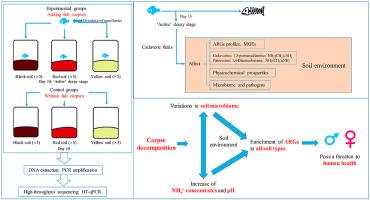Environmental Pollution ( IF 7.6 ) Pub Date : 2021-06-11 , DOI: 10.1016/j.envpol.2021.117560 Tianshu Feng 1 , Wanghong Su 1 , Jianxiao Zhu 2 , Jiawei Yang 1 , Yijie Wang 1 , Rui Zhou 1 , Qiaoling Yu 1 , Huan Li 3

|
As a common natural phenomenon, corpse decomposition may lead to serious environmental pollution such as nitrogen pollution. However, less is known about antibiotic resistance genes (ARGs), an emerging contaminant, during corpse degradation. Here, ARGs and microbiome in three soil types (black, red and yellow soil) have been investigated between experimental and control groups based on next-generation sequencing and high-throughput quantitative PCR techniques. We found that the absolute abundance of total ARGs and mobile genetic elements (MGEs) in the experimental groups were respectively enriched 536.96 and 240.60 times in different soil types, and the number of ARGs in experimental groups was 7–25 more than that in control groups. For experimental groups, the distribution of ARGs was distinct in different soil types, but sulfonamide resistance genes were always enriched. Corpse decomposition was a primary determinant for ARGs profiles. Microbiome, NH4+ concentrates and pH also significantly affected ARGs profiles. Nevertheless, soil types had few effects on ARGs. For soil microbiome, some genera were elevated in experimental groups such as the Ignatzschineria and Myroides. The alpha diversity is decreased in experimental groups and microbial community structures are different between treatments. Additionally, the Escherichia and Neisseria were potential pathogens elevated in experimental groups. Network analysis indicated that most of ARGs like sulfonamide and multidrug resistance genes presented strong positively correlations with NH4+ concentrates and pH, and some genera like Ignatzschineria and Dysgonomonas were positively correlated with several ARGs such as aminoglycoside and sulfonamide resistance genes. Our study reveals a law of ARGs’ enrichment markedly during corpse decomposing in different soil types, and these ARGs contaminant maintaining in environment may pose a potential threat to environmental safety and human health.
中文翻译:

尸体分解增加了鱼类模型中不同土壤类型抗生素抗性基因的多样性和丰度
尸体腐烂作为一种常见的自然现象,可能会导致氮污染等严重的环境污染。然而,在尸体降解过程中,对抗生素抗性基因 (ARG)(一种新出现的污染物)知之甚少。在这里,基于下一代测序和高通量定量 PCR 技术,在实验组和对照组之间研究了三种土壤类型(黑色、红色和黄色土壤)中的 ARG 和微生物组。我们发现实验组总ARGs和移动遗传元件(MGEs)的绝对丰度在不同土壤类型中分别富集了536.96和240.60倍,实验组ARGs数量比对照组多7-25个. 对于实验组,ARGs 在不同土壤类型中的分布不同,但磺胺类抗性基因总是富集的。尸体分解是 ARGs 配置文件的主要决定因素。微生物组,NH4个+浓缩物和pH值也显著影响的ARG轮廓。然而,土壤类型对 ARGs 的影响很小。对于土壤微生物组,一些属在实验组中升高,例如Ignatzschineria和Myroides。实验组的 alpha 多样性降低,处理之间的微生物群落结构不同。此外,埃希氏菌和奈瑟菌是实验组中升高的潜在病原体。网络分析表明,大多数ARGs如磺胺和多药耐药基因与NH 4 +浓缩物和pH值呈强正相关,一些属如Ignatzschineria和Dysgonomonas呈正几的ARG如氨基糖苷类和磺酰胺抗性基因相关。我们的研究揭示了不同土壤类型尸体腐烂过程中ARGs显着富集的规律,这些ARGs污染物在环境中的维持可能对环境安全和人类健康构成潜在威胁。











































 京公网安备 11010802027423号
京公网安备 11010802027423号